
|
Features
|
|
|
|
Books
|
|
|
|
Fun & Games
|
|
|
|
Contact Us
|
|
|
Night Hawk Stories... Entry 26
Secrets Of Snow Hunting In Anticosti
by John E. Phillips
Page 1
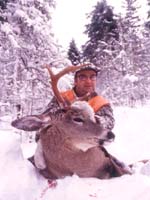 Because
I study deer, their habits and the best way to hunt deer, I went north
to learn how to hunt more effectively. Now you might wonder why anyone
who lived in Alabama with its more than 1.6 million deer and where a hunter
could bag 100 deer each year would want to hunt deer somewhere else. I
wanted to know more about whitetails. I had many of my former beliefs
disproved at Anticosti Island in the Province of Quebec, Canada.
Because
I study deer, their habits and the best way to hunt deer, I went north
to learn how to hunt more effectively. Now you might wonder why anyone
who lived in Alabama with its more than 1.6 million deer and where a hunter
could bag 100 deer each year would want to hunt deer somewhere else. I
wanted to know more about whitetails. I had many of my former beliefs
disproved at Anticosti Island in the Province of Quebec, Canada.
Although some hunters had claimed to use deer tracks to determine the sex of a deer or its age, I'd always considered these outdoor skills as fictional. But when I went north to Canada, I watched my guide Norman LeBrun distinguish between buck tracks and doe tracks and correctly determine how much time would pass before we would find the deer from the tracks the animal had made.
 We
had hunted all morning long. Near noon, snow began to fall on Anticosti
Island in the Gulf of St. Lawrence. LeBrun suggested we go to a small
shelter for lunch because he believed the weather would become severe.
Just as we arrived at the hut, a whiteout hit. As we looked out the window
while drinking hot coffee and eating a warm meal, I understood how a hunter
could become disoriented and then lost in such a deluge of flaky white.
We
had hunted all morning long. Near noon, snow began to fall on Anticosti
Island in the Gulf of St. Lawrence. LeBrun suggested we go to a small
shelter for lunch because he believed the weather would become severe.
Just as we arrived at the hut, a whiteout hit. As we looked out the window
while drinking hot coffee and eating a warm meal, I understood how a hunter
could become disoriented and then lost in such a deluge of flaky white.
When the snow stopped, LeBrun told us that the fresh snow should allow us to locate a buck easily, because, "All we have to do is see a trail. Then we can snow-track the deer."
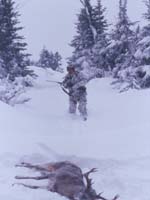 We
climbed back into the truck and rode the backwoods roads deep into the
interior of the 138-mile-long, 35-mile-wide island known as Anticosti.
This island often hosts 2,500 to 4,000 hunters each season. However, with
a whitetail population of more than 100,000 animals, everyone finds plenty
of white-tailed bucks there to hunt.
We
climbed back into the truck and rode the backwoods roads deep into the
interior of the 138-mile-long, 35-mile-wide island known as Anticosti.
This island often hosts 2,500 to 4,000 hunters each season. However, with
a whitetail population of more than 100,000 animals, everyone finds plenty
of white-tailed bucks there to hunt.
As we drove down the road, LeBrun stopped the truck quickly, got out and walked to the front of the vehicle. I followed.
While LeBrun studied fresh deer tracks in the snow, he explained, "That's a buck track. Since the deer is moving slow, we should be able to catch up to him in no more than 15 minutes."
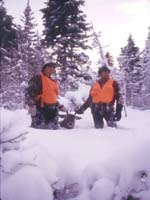 Reason
and knowledge would not allow me to accept the information I heard without
closer scrutiny. All my life I had believed you couldn't tell the sex
of a deer by its track nor could you tell the track's age by looking at
it. So before I embarked on this wild goose chase through fresh snow with
a man I had met only the day before, I wanted to know more about snow-tacking
whitetails.
Reason
and knowledge would not allow me to accept the information I heard without
closer scrutiny. All my life I had believed you couldn't tell the sex
of a deer by its track nor could you tell the track's age by looking at
it. So before I embarked on this wild goose chase through fresh snow with
a man I had met only the day before, I wanted to know more about snow-tacking
whitetails.
When I asked LeBrun how he could tell the track belonged to a buck, he replied, "Notice the deer seems to drag his toes as he lifts his foot to walk. Bucks make this kind of track, and does don't. Most of the time when you see a track with back toes dragging, the deer generally will be a buck."
Even as LeBrun spoke, my mind questioned his explanation. He still hadn't convinced me that I had looked at a buck track. Next I asked LeBrun why he thought we could catch up to the deer in 15 minutes.
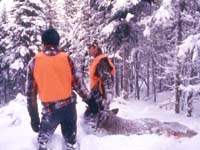 "See
how close the tracks are spaced together," LeBrun commented. "From this
information, I can tell the buck is walking.
"See
how close the tracks are spaced together," LeBrun commented. "From this
information, I can tell the buck is walking.
"Snow only stopped falling about 10 minutes ago, but since no snow was inside this track, we know the deer crossed the road after the snow. He can't be more than 15 minutes in front of us if he continues to walk at the same pace he's walking now. However, if we stand here and continue to talk, we may not catch up to that buck until next week. If you want to go kill a buck, get your gun, and let's go."
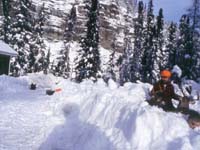 I
loaded my Browning .243 rifle with ammunition and checked my Nikon 3-9X
variable scope, I'd covered with Saran Wrap to insure that I could see
through it. From LeBrun, I had learned that when you didn't have see-through
scope covers, the snow you knocked off the tree limbs as you walked could
fall into your scope. Then when you spotted a buck, you'd have to clean
the snow out of the scope before you could see to shoot. Wrapping Saran
Wrap around both ends of the scope and securing it to the scope with rubberbands
would give me a quick, inexpensive scope covering that would prevent the
snow from filling the scope and allow me to see clearly and accurately
though the scope.
I
loaded my Browning .243 rifle with ammunition and checked my Nikon 3-9X
variable scope, I'd covered with Saran Wrap to insure that I could see
through it. From LeBrun, I had learned that when you didn't have see-through
scope covers, the snow you knocked off the tree limbs as you walked could
fall into your scope. Then when you spotted a buck, you'd have to clean
the snow out of the scope before you could see to shoot. Wrapping Saran
Wrap around both ends of the scope and securing it to the scope with rubberbands
would give me a quick, inexpensive scope covering that would prevent the
snow from filling the scope and allow me to see clearly and accurately
though the scope.